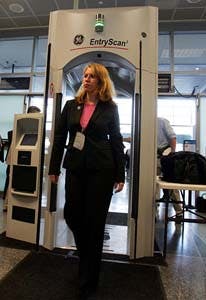WASHINGTON, D.C. -- Rear Adm. David M. Stone, USN (Ret.), Assistant Secretary of Homeland Security for the Transportation Security Administration (TSA), today announced the beginning of Phase II of the Airport Access Control Pilot Program in which TSA will test advanced technologies to enhance access control to secure areas of an airport. TSA will pilot the technologies in five international airports: Boston's Logan, New York's John F. Kennedy, Denver, Orlando and Salt Lake City. The technology will be deployed in June 2005 and the field tests will run through summer 2005.
"These programs will deploy various technologies, including state-of-the-art video surveillance, Radio Frequency Identification (RFID) cards, iris scan readers, and hand geometry readers to protect against unwanted guests going to secure areas of the airport," Admiral Stone said.
The following airports will partner with TSA and pilot the following technologies:
- Working with Massachusetts Port Authority (Massport), TSA will take advantage of Logan International Airport's natural water boundary to test an advanced water perimeter intrusion detection system. At Logan, Massport and TSA have already partnered with clam diggers who have undergone a background check to be an additional set of "eyes and ears" to monitor the area for suspicious activities. The new system will provide the clam diggers with GPS voice recognition cell phones to report any trouble as well as infrared intrusion detection system that will identify authorized individuals near active runaways.
- The Port Authority of New York and New Jersey, along with TSA, will test a barrier-free boundary surrounding a cargo warehouse at John F. Kennedy. All persons who are authorized to enter the secure area will have a personal RFID card and will need to have their fingerprint scanned by a fingerprint reader prior to gaining access. In addition, TSA will deploy a state-of-the-art video surveillance system to monitor access. The barrier-free area is within the cargo warehouse.
- Working with Greater Orlando Aviation Authority, TSA will test equipment to monitor access of vehicles into secure areas of the airport at Orlando International Airport (MCO). TSA will analyze the use of a dual iris scan recognition reader at a vehicle access gate to allow only authorized personnel and vehicles through the gate.
- Denver International Airport will to test a barrier-free boundary surrounding a cargo warehouse at the airport using technology including ultrasonic emitters and microwave sensor. In this test, all persons who are authorized to enter the secure area must to have their fingerprint scanned by a fingerprint reader prior to gaining access. Advanced video surveillance system will also be installed to monitor access.
- Salt Lake City Department of Airports will focus on enhancing access control to the baggage area entrance which is part of the non-public, secure side of the airport. The technologies will include a hand geometry reader and a video motion surveillance analysis system to prevent personnel from piggybacking through the door.
These technologies will be tested to determine both their effectiveness and impact on airport operations. TSA will collect and share data on the various technologies with the industry so they may utilize it for future projects.





